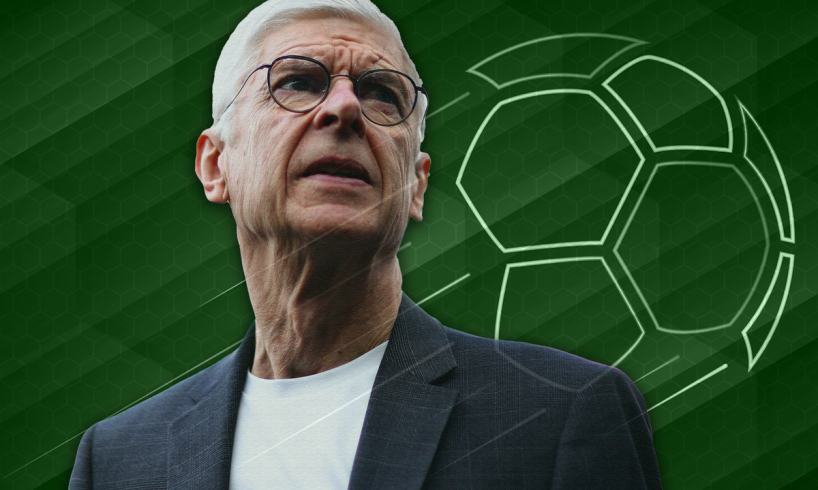
(Getty/iStock)
There are still moments when Arsene Wenger sits at his desk in Zurich – of course overlooking every type of pitch, from 11-a-side to beach football – and wonders about the scale of the task he has taken on. Perhaps facing Sir Alex Ferguson or Pep Guardiola was easier.
“When you sit here and think, ‘I have to improve football in the world’, you realise that it’s not easy, you know,” Wenger laughs, before gesturing to the pitches below. “I would rather say ‘give me a team and down there I can show you what I can do’. But once you sit here and say, ‘how much, 211 countries? OK, thank you very much!’”
And yet, as great as Wenger’s managerial legacy is, there are so many moments in speaking to him about his role as Fifa chief of global football development when it’s impossible not to wonder how much the wider game could have benefitted from his rare insight.
“I can understand that as long as I was at Arsenal I didn’t care too much about that because I had to win the next game,” he says. “Once you have a global vision of world football, you realise something is not right.”
Wenger has probably attracted most focus in the role for fronting the move for a biennial World Cup, but his real work – and a truly great responsibility – is raising the level of the sport across the planet so every country and every child has a chance.
“I believe really football can change the world,” he said at the Fifa Women’s Football Convention in Sydney last month. “Not just on the football side, the human side. That’s the next step.”
Wenger is sitting here on transfer deadline day explaining in a wide-ranging interview with the Independent exactly how. It is a particular challenge when he goes to countries like Cote d’Ivoire and the president tells him they haven’t had an official youth game in five years.
“And here you have Yaya Toure, Didier Drogba, Kolo Toure, you know we have the players, it’s a football country,” Wenger says.
“I always think there’s a little girl or a little boy who has a dream, has the talent and no opportunity.”
It’s all the more frustrating for Wenger since there is now a strong argument that football is the most popular cultural pursuit the planet has ever seen, particularly with the way it spreads into the United States and India, all while developing huge money. Most of that, however, stays in one corner of the globe.
“In Europe, it’s all done and we are a little bit not conscious of the needs elsewhere, because in some countries there’s no [football] education… it’s incredible.
“Football is conquering the world at an unstoppable speed and at the moment there is a dysfunction between the audience and the practice in some countries.”
In other words, there aren’t the resources to match the interest: the dream.
Arsene Wenger is now in charge at Fifa as the Chief of Global Football Development (Getty Images)
Wenger talks about how the first steps to solving this are creating free centres of excellence for the best young talent and spreading out from there to create grassroots structures. Fifa is currently funding 25 academies, and the former Arsenal manager recently had the coaches involved at his office for the final preparations. Such is the nature of the discussion and the nature of his thinking, though, that an hour-long interview spreads into all manner of areas. They include:
How football may have to “create striker schools” to solve a lack of goalscorers
How modern academies offer high technical quality but have meant “we lose a bit of that freedom, that creativity”
How pressing has affected that
“The trend in some academies is to recreate park football”
How football isn’t producing anywhere near as many good players as it could
“Does the world produce enough good players? I think no”
How this has led to an inflated transfer market, where “everybody thinks the same”
Why countries like Croatia and Uruguay are so repeatedly successful
How football is addressing these issues
There’s then the vintage manner he offers profound insights about football, and seemingly simple lines that capture so much, just in sitting there talking about it. Employing Wenger to directly study the game only amplifies that, which is what he has spent the last few years doing since taking the job in 2019.
“We analysed football in 205 countries and we found in half of the world there’s a deficit in education… which I mean as identification of talent, coaching programme, quality of coaching, quality of the competitions and integration in the first team.
“What we basically found out by analysing the whole world is there’s a huge correlation between the quality of the educational system and the results in the first team. That was mathematics.
“We proposed to each member association to help them to develop the education. Basically, if you have no education in life, you have no chance so my purpose was of course to change that.”
Some of the challenges themselves come from what has been one of the most transformational factors in the modern game. That is the way a sequence of wealthy western European countries like France, Spain, Germany and now England have essentially industrialised talent production. Wenger himself points to how Clairefontaine-fashioned underage teams were thrashing England’s when he arrived at Arsenal in 1996, but that no longer happens. England has caught up. It’s put to him that the old line from journalist and former footballer Eamon Dunphy – that “dictatorships and poverty” produce good footballers – no longer applies.
Arsene Wenger speaks to Independent chief football writer Miguel Delaney (Miguel Delaney)
It is typical Wenger, though, that immediately leads to another fascinating path of discussion.
“No, no, I would say it’s quality of education. What has dropped in recent generations is that of course park football has disappeared and now the trend in some academies is to recreate again what happened before. The game itself is a good coach.
“Why? Because, if I play in the park, I have to make decisions. If I’m shrewd enough to think why did that not come off, and have a right assessment, the next time I am in the same situation I am correct. We have lost that a little bit. And maybe today we are overcoaching a little bit sometimes, and we lose a bit that freedom, that creativity, that individual personalised training that happened before.”
A classic example of what Wenger is talking about comes from one of the most famous goals of all time. In bearing down on Peter Shilton in the 1986 World Cup quarter-final, Diego Maradona remembered a previous occasion when the England goalkeeper went one way. So, at this moment of heightened tension and consequence, the Argentina great went the other way.
The rest is history, but the evolution since has removed something from the game’s present. Wenger believes the greatest cost of the more homogenised academy system is with that fundamental of the game – putting the ball in the back of the net. Or, more specifically, he believes it has resulted in a decline in strikers that has inevitably brought a decline in classic centre-halves, too.
The hermetically sealed nature of modern academies has meant young players are not “educated for the fight” in the same way.
“I think football has improved dramatically all over the world but some positions today are more difficult to find because maybe the evolution and the quality of the coaching has suppressed natural fighting qualities in positional play.
“The emphasis has become more on quality of passing, quality of coaching. What you lost from the wild football is, if you go out now to a training session here, it will be built to start with passing, after that the quality of possession.
“Before, the training pitches were not good, so you had to lift the ball to the striker. A striker had to fight to get the ball so, naturally, you develop qualities that, with the passing, you develop a little bit less.
“If we go out there and play in the park, you think you have to score goals to win the game. Then you have to fight.
“As well, the man-to-man marking has disappeared so it’s easier to get the ball. You are less confronted with fight. You see that in Germany. Since they play zonal they don’t produce strikers anymore.
“If you look at the global evolution, we have moved away from defenders who only defend, from strikers who only attack, from midfielders where some defend and some attack, to be more demanding completely. Technically, today, the players in every position need to be better because of higher demands than 30 years ago. The pace is higher, the athletic side is higher. So, today, the right-back is technically better, the centre-back is technically better. Of course, you had exceptions in history but maybe it has also kicked out specificity; the creativity of some players because of the pace.
“Overall, every player in each position has become a more complete player. I would say because we have gone in a more specific passing game today, the demands on the striker to score is smaller than it was before. Jurgen Klinsmann made an interesting point on that at the World Cup. He said to me. ‘I played with only one thing: I have to score. I feel the strikers today judge their own game by how they combine with other players. I only judged my game on did I score or not.’”
So, how does football solve this? Wenger believes this is being deeply considered, and that Erling Haaland represents a throwback who could point to a new spin on an old way.
“At the end of the day, no matter what you do, football is always the quality of the one who gives you the ball and the one who puts it in the net. It’s true you find more good passers now than finishers.
“And you can develop these qualities. I think it’s something that will be addressed. Now, after 15 years of age, we have to start specialisation and positional play.
“Finishing under pressure. Finishing by being challenged and the quality of the movement… to get that responsibility on their shoulders, that their focus every day is to score, to fix them targets. So maybe we have to create striker schools, internally inside the club, or more specific work. I think it’s on the way to happening now.
Erling Haaland celebrates his latest hat-trick for Man City (PA Wire)
“If I look at Haaland, Haaland is for me the real typical striker. He looks like he is ready for the fight, ready to be focused on only scoring goals. Like [Olivier] Giroud is a real striker in mentality, that explains why he’s still playing at 36, 36. And [Zlatan] Ibrahimovic, [Karim] Benzema, they have been educated for the fight, they have been educated to finish as well.
“In France now, you have some good strikers again. Germany, where they had big strikers, they have less. They are thinking now how they can change that again.”
It may bring a change in centre-halves, too, given how interlinked the two roles are. As someone who used to play in that area himself, Wenger now feels Jamie Carragher is right that it might be the most demanding position in the game.
“At the end of my career, you wanted centre-backs to play out from the back. Today you want the centre-back to play like a number-10 and to defend as well, to be tough. Fighting and to play. It’s tough to always find that balance.”
That, for Wenger, is also where the beauty lies.
“You know, football is magic for me because there is a good balance we have to make between the technical, the physical and the tactical,” Wenger adds. “So, for example, one of the things we are cautious to change is the offside rule because we want to keep that balance right.
If I play for example against [Kylian] Mbappe, the only advantage I have is to play him offside. If offside is even more difficult for me to play, I have no chance anymore. So what can I do? When his team has the ball I can run in the box because I wait for him. The rest, I have no chance! Haaland is the same.
“So, when you press, the defence has to move up, and the space is behind me. Against the quick players, it becomes even more difficult. That is a good example of the evolution of the game. The attack gives you a new problem. The defence responds by analysing your superiority. Then the attack finds a new solution and creates again a new problem and the defence comes behind.
“So I would say now how do you slowly fight against the pressing, it’s by getting the players better technically. Evolution is created by opposition.”
There is a similar dynamic in the transfer market, which has influenced some of this summer’s excesses. Whereas it used to be that Luis Figo and Zinedine Zidane would command the record fees because they were in their prime and had established careers that offered absolute proof of quality, that sort of expenditure is now geared towards much younger talent. Even teenagers like Rasmus Hojlund and Jude Bellingham have gone for huge fees. Part of that is their ability, particularly with Bellingham. Part of it is the premium on their positions, particularly with a striker like Hojlund. Part of it is the thinking.
“What is happening now is because clubs think that confirmed players are so expensive, they try to fight for the younger players. They are thinking they will get them at the cheaper price. The fact that everybody thinks the same makes the prices of the younger players too high, in my opinion. Why? Because it is at 19, 20, 21 where you see if the player has the capacity to cope with the pressure.
“For the confirmed players, with the high levels of transfers come high wages and even clubs like Real Madrid cannot cope with both. What is the trend in the top markets? They get the players to go to the end of the contract to be capable of giving the players the wages they want. And it looks like now the competition with Saudi Arabia will even increase that, so overall I would say there’s more fight for the young players.
“But two questions. Does the world produce enough good players? I think no, and I believe as well that the prices depend on the identity of the buyer. If he is tomorrow president of Young Boys Berne [gesturing towards Fifa media officer Stefan Curtis] and I am Arsenal, I will come to see him. ‘Who are you? Arsenal, OK, English, I have a good player.’ In Switzerland he would sell for £5m, in England for £50m. So somewhere, the identity of the buyer fixes the price.”
It’s a theme that brings together much of Wenger’s work, and why it is so important for the game, as well as how it’s played.
So much of the money is concentrated in western Europe, and particularly the Premier League, which has in turn generated even more mega interest around the rest of the world. Many countries don’t have anything like the same resources, though, which has meant they cannot maximise the potential talent. The talent they do have is meanwhile quickly bought up, reducing the quality of their domestic competitions as well as the money the football culture can consequently invest.
Arsene Wenger insists young players are overvalued in the current market (Getty Images)
Part of Wenger’s great mission, beyond just changing the world by changing the football world, is to lift the level of their entire game; to restore a vitality.
“I believe the globalisation of the world has concentrated the big money in a few number of clubs,” Wenger emphasises. “his few number of clubs has a huge potential and the rest of the world watches the Premier League. So, what does a guy in China or South Africa do in the morning? He thinks ‘ah, Premier League.’ Why? Because the best players play there and that reinforces the Premier League even more, so that means the concentration of the money in the small number of clubs has created even an inflated market.
“And then once you have all the best players in the world in the same league, that means if I have a Chinese player in the Premier League, all China will watch the Premier League. That reinforces even more that superiority.
“What I want to create is that in Angola, for example, we produce as well players who are good enough to produce a quality in their own championship, that the guy can have a choice. ‘Yes, I will still watch the Premier League but in my league something is happening as well – oh, here we have as well some good players’. Then it creates interest.
“That’s why I tell you the deficit of education today is detrimental to the quality of the championships and as well to the quality of the national teams worldwide.”
This is the “dysfunction” Wenger spoke about.
“For example, the television audiences in India are very high, in China very high, but the players are not educated at the same pace,” Wenger maintains. “What we want is to provide them with the capacity to play. That’s our target.”
If the targets are the same for every country, the challenges are different. While an emphasis will inevitably be on countries of inferior resources, those with more resources can bring the opposite problem, which is privatised football; or coaching that costs parents more money. The most obvious example is the United States’ “pay to play” system.
“We have in some countries a lack of football culture,” Wenger concedes. “A lack sometimes of structures, and in some countries, because the private academies have taken over, a child from a poor background cannot pay to get into the football school. It’s exactly the reverse of what I want to do.”
It’s also the opposite of what football represents.
“You can play with an orange or you can make a ball with paper. That’s why football is so popular. But today if you want to get to a good level of education in football, in some countries you don’t get it. I find that not right because, in many countries, there are some private initiatives, but the parents have to pay to get the children in there.
“For me it doesn’t matter if you’re rich or poor. If you are good, you come in. Our academies are free, just open to talent. You have to adapt and find a solution in every country.”
***
It is here when another Wenger thought opens a whole new avenue of discussion. In this case, it is how some national teams constantly overperform.
“What we found out, and what explains countries like Croatia, like Uruguay – who are small countries, three million people – is that a number of good players on a short surface is more important than a number of good players on a big surface.”
In other words, they’ve realised how to use their size to an advantage, by being able to bring the best talent together more easily and enjoy a multiplying effect.
“I realised 40 years ago from a study I made for Netherlands, why I want to put the best with the best. Because they play against each other, they stimulate each other. That explains countries like Netherlands, Croatia, Uruguay.
“They keep creating teams and players because they have a good level of education and identification of talent.
“Croatia was in the last four of the last two World Cups so that means success is not limited to big countries. It is just limited to the quality of education and organisation.”
Arsene Wenger discussed the key to countries such as Croatia consistently punching above their weight (Getty Images)
It is also a newly romantic virtue of international, that has inverted a lot of football history. It now offers a vitality that the club game can’t. No matter how big the population, international managers have to make do with what they have. The biggest clubs just buy what they lack.
“Yes, the international team game is rewarding the quality of the educational work. The club game, and I am a big fan of big clubs, is the recruitment of the best players from all over the world. It’s fantastic, but I think you need the two, to give everybody the chance.
“For example, Croatia today cannot compete with their clubs, at the top level, because the players leave early. Then they come back and compete with their national team so they are rewarded for the quality of their work.
“That’s our target. In Africa, it’s the same. In Concacaf it’s the same. I come back from Australia, football is unstoppable.
“The boy or the girl wants the dream. When they watch football players, when they see the World Cup, when you watch it, you have the dream, which is to play football and to lift the World Cup. We create the dream. But we do not have at the moment the capacity to fulfil this dream.”
That’s what he is pondering as he sits at that desk. It is in some ways the same as when he was a club manager, speaking to why the game is so popular. It’s to fulfil the dream.






